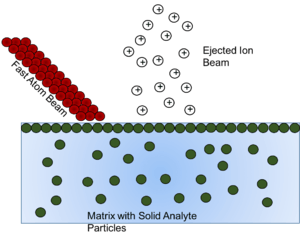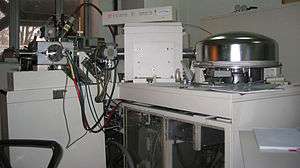Fast atom bombardment

Fast atom bombardment (FAB) is an ionization technique used in mass spectrometry in which a beam of high energy atoms strikes a surface to create ions.[1][2][3] It was developed by Michael Barber at the University of Manchester.[4] When a beam of high energy ions is used instead of atoms (as in secondary ion mass spectrometry), the method is known as liquid secondary ion mass spectrometry (LSIMS).[5][6][7] In FAB and LSIMS, the material to be analyzed is mixed with a non-volatile chemical protection environment, called a matrix, and is bombarded under vacuum with a high energy (4000 to 10,000 electron volts) beam of atoms. The atoms are typically from an inert gas such as argon or xenon. Common matrices include glycerol, thioglycerol, 3-nitrobenzyl alcohol (3-NBA), 18-crown-6 ether, 2-nitrophenyloctyl ether, sulfolane, diethanolamine, and triethanolamine. This technique is similar to secondary ion mass spectrometry and plasma desorption mass spectrometry.
Ionization mechanism

FAB is a relatively low fragmentation (soft) ionization technique and produces primarily intact protonated molecules denoted as [M + H]+ and deprotonated molecules such as [M - H]−. The nature of its ionization mechanism is similar to matrix-assisted laser desorption/ionization (MALDI)[8][9] and chemical ionization.[10]
Continuous flow fast atom bombardment
In continuous flow fast atom bombardment (CF-FAB), the sample is introduced into the mass spectrometer insertion probe through a small diameter capillary.[11] When a metal frit is used to disperse the liquid on the probe, the technique is known as frit FAB.[12][13] Samples can be introduced by flow injection, microdialysis, or by coupling with liquid chromatography.[14] Flow rates are typically between 1 and 20 µL/min.[12] CF-FAB has a higher sensitivity compared to static FAB[15]
Applications

The first example of the practical application of this FAB was the elucidation of the amino acid sequence of the oligopeptide efrapeptin D. This contained a variety of very unusual amino acid residues.[16] The sequence was shown to be: N-acetyl-L-pip-AIB-L-pip-AIB-AIB-L-leu-beta-ala-gly-AIB-AIB-L-pip-AIB-gly-L-leu-L-iva-AIB-X. PIP = pipecolic acid, AIB = alpha-amino-isobutyric acid, leu = leucine, iva = isovaline, gly = glycine. This is a potent inhibitor of mitochodrial ATPase activity.
References
- ↑ Morris HR, Panico M, Barber M, Bordoli RS, Sedgwick RD, Tyler A (1981). "Fast atom bombardment: a new mass spectrometric method for peptide sequence analysis". Biochem. Biophys. Res. Commun. 101 (2): 623–31. doi:10.1016/0006-291X(81)91304-8. PMID 7306100.
- ↑ Barber, Michael; Bordoli, Robert S.; Elliott, Gerard J.; Sedgwick, R. Donald; Tyler, Andrew N. (1982). "Fast Atom Bombardment Mass Spectrometry". Analytical Chemistry. 54 (4): 645A–657A. doi:10.1021/ac00241a817. ISSN 0003-2700.
- ↑ Barber M, Bordoli RS, Sedgewick RD, Tyler AN (1981). "Fast atom bombardment of solids (F.A.B.): a new ion source for mass spectrometry". Journal of the Chemical Society, Chemical Communications (7): 325–7. doi:10.1039/C39810000325.
- ↑ Barber, M.; Bordoli, R.S.; Sedgewick, R.D.; Tyler, A.N., Nature, 293, 1981, pp270-275
- ↑ Stoll, R.G.; Harvan, D.J.; Hass, J.R. (1984). "Liquid secondary ion mass spectrometry with a focussed primary ion source". International Journal of Mass Spectrometry and Ion Processes. 61 (1): 71–79. Bibcode:1984IJMSI..61...71S. doi:10.1016/0168-1176(84)85118-6. ISSN 0168-1176.
- ↑ Dominic M. Desiderio (14 November 1990). Mass Spectrometry of Peptides. CRC Press. pp. 174–. ISBN 978-0-8493-6293-4.
- ↑ De Pauw, E.; Agnello, A.; Derwa, F. (1991). "Liquid matrices for liquid secondary ion mass spectrometry-fast atom bombardment: An update". Mass Spectrometry Reviews. 10 (4): 283–301. doi:10.1002/mas.1280100402. ISSN 0277-7037.
- ↑ Pachuta, Steven J.; Cooks, R. G. (1987). "Mechanisms in molecular SIMS". Chemical Reviews. 87 (3): 647–669. doi:10.1021/cr00079a009. ISSN 0009-2665.
- ↑ Tomer KB (1989). "The development of fast atom bombardment combined with tandem mass spectrometry for the determination of biomolecules". Mass Spectrometry Reviews. 8 (6): 445–82. doi:10.1002/mas.1280080602.
- ↑ Székely, Gabriella; Allison, John (1997). "If the ionization mechanism in fast-atom bombardment involves ion/molecule reactions, what are the reagent ions? The time dependence of fast-atom bombardment mass spectra and parallels to chemical ionization". Journal of the American Society for Mass Spectrometry. 8 (4): 337–351. doi:10.1016/S1044-0305(97)00003-2. ISSN 1044-0305.
- ↑ Caprioli, Richard M. (1990). "Continuous-flow fast atom bombardment mass spectrometry". Analytical Chemistry. 62 (8): 477A–485A. doi:10.1021/ac00207a715. ISSN 0003-2700.
- 1 2 Jürgen H Gross (14 February 2011). Mass Spectrometry: A Textbook. Springer Science & Business Media. pp. 494–. ISBN 978-3-642-10709-2.
- ↑ Caprioli, R. M. (1990). Continuous-flow fast atom bombardment mass spectrometry. New York: Wiley. ISBN 0-471-92863-1.
- ↑ Abian, J. (1999). "The coupling of gas and liquid chromatography with mass spectrometry". Journal of Mass Spectrometry. 34 (3): 157–168. doi:10.1002/(SICI)1096-9888(199903)34:3<157::AID-JMS804>3.0.CO;2-4. ISSN 1076-5174.
- ↑ Tomer, K. B.; Perkins, J. R.; Parker, C. E.; Deterding, L. J. (1991-12-01). "Coaxial continuous flow fast atom bombardment for higher-molecular-weight peptides: comparison with static fast atom bombardment and electrospray ionization". Biological Mass Spectrometry. 20 (12): 783–788. doi:10.1002/bms.1200201207. ISSN 1052-9306. PMID 1812988.
- ↑ Bullough,D.A., Jackson C.G.,Henderson, P.J.F., Cottee, F.H.,Beechey,R.B. and Linnett, P.E. Biochemistry International (1981) 4, 543-549